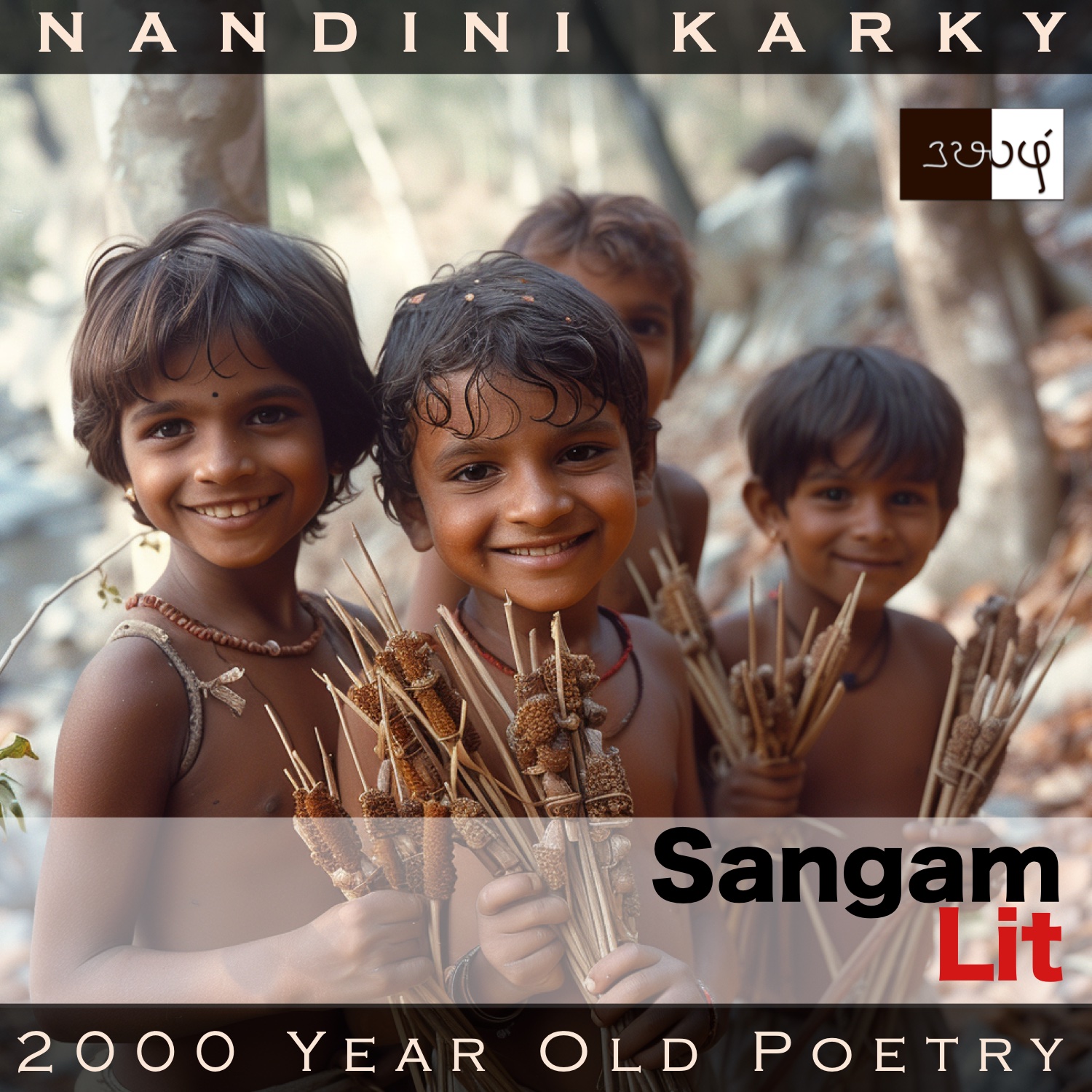Podcast: Play in new window | Download
Subscribe: Apple Podcasts | Spotify | Amazon Music | Android | iHeartRadio | Email | TuneIn | RSS | More
In this episode, we perceive detailed descriptions about the children of hunters, as depicted in Sangam Literary work, Puranaanooru 324, penned by the poet Aalathoor Kizhaar. The verse is situated in the category of ‘Vaagai Thinai’ or ‘Victory’ and speaks about the support a leader extends to his superior king.

வெருக்கு விடை அன்ன வெகுள் நோக்குக் கயந் தலை,
புள் ஊன் தின்ற புலவு நாறு கய வாய்,
வெள் வாய் வேட்டுவர் வீழ் துணை மகாஅர்
சிறியிலை உடையின் சுரையுடை வால் முள்
ஊக நுண் கோல் செறித்த அம்பின்,
வலாஅர் வல்வில் குலாவரக் கோலி,
பருத்தி வேலிக் கருப்பை பார்க்கும்
புன் புலம் தழீஇய அம் குடிச் சீறூர்,
குமிழ் உண் வெள்ளை பகு வாய் பெயர்த்த
வெண் காழ் தாய வண் கால் பந்தர்,
இடையன் பொத்திய சிறு தீ விளக்கத்து,
பாணரொடு இருந்த நாணுடை நெடுந்தகை
வலம் படு தானை வேந்தர்க்கு
உலந்துழி உலக்கும் நெஞ்சு அறி துணையே.
A verse rich in details about that ancient place! The poet’s words can be translated as follows:
“With piercing looks, akin to that of the male wild cat, huge heads, and mouths smelling like the flesh of the bird meat just had, are the sons of white-mouthed hunters. These young children have a lot of affection for each other. Taking the hollow, white thorns of the ‘udai’ tree with small leaves, and sticking it on a thick stem of the ‘bristly needle grass’, the young children make arrows. Then, bending their sturdy bows amidst the hedges of the cotton tree, they look for black rats. Such is the drylands domain of the beautiful, little town of the lord. Here, white sheep feed on the fruits of the ‘Kumil tree’ and drop their dung all around, and so those white seeds then sprout and stand as sturdy canopies. In this spot, in the light of a small flame lit by a shepherd, the great and humble-natured lord receives bards many. When his king, who has a victorious army, suffers distress any, he is such a companion that his heart feels it instantaneously!”
Time to delve deeper into these words. The poet first mentions the kind of look a wild cat has. Even the domestic cats I have seen have something of a penetrating gaze and so I can imagine how their cousins in the wild would be! Connecting the look that these wild cats have to the same in the children of some hunters, the poet then goes on to describe them as having big heads and also how their mouths smell of the flesh of birds they just feasted on. But the most striking detail about these children that the poet gives is the way they seek out each other with affection. After this detail about their bond, the poet goes on to depict them as carving arrows out of the thorns of the ‘umbrella thorn’ tree and the stems of the ‘bristly needle grass’. With their little weapons, they stand keeping a watch out for black rats, amidst the cotton hedges, the poet describes and says this is the drylands town of the lord being sung about.
Zooming on to the whereabouts of this lord, we find him under the shade of huge trees as canopies, which have sprouted from the white teak seeds within the pellets of white sheep. Here in the light of a lamp lit by a shepherd, this leader meets with bards, the poet details, telling us he rules over a humble domain of drylands town, without any water resources, and yet he has the compassion to shower upon his supplicants. And finally, the poet finishes with another detail about this leader, saying if any trouble were to come near the superior king, who patronises this leader, such was this leader’s bond with that king that his heart would know it instantly and he would offer all possible support for that king.
Yet again, Sangam poets stress on the fact that you don’t have to come from great wealth and resources. All you need is the heart to stand and face the fury of the battle. Interesting how the poet starts with a note on the affection among those young hunter children and ends with a depiction of the same between this leader and his king. Through this, this ancient poet weaves those unbreakable threads of friendship, that one can relate to, and relish, no matter the time and space.




Share your thoughts...